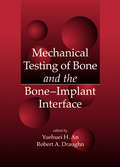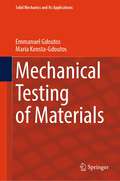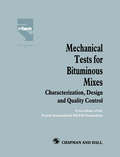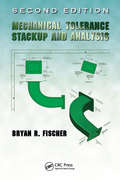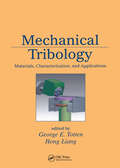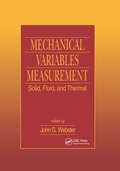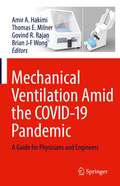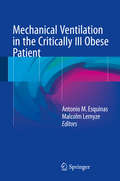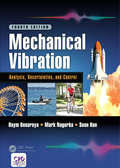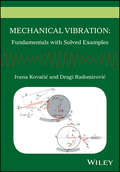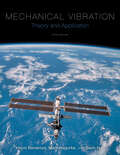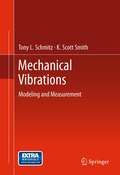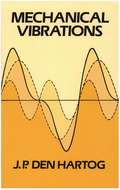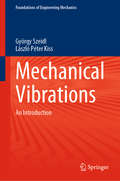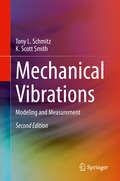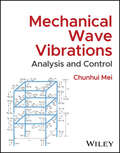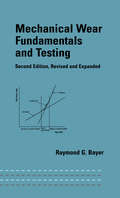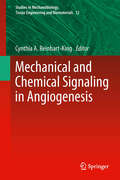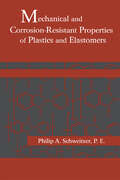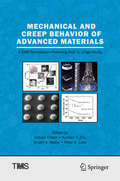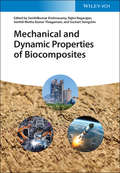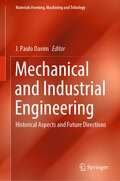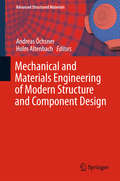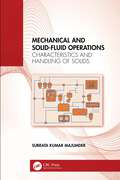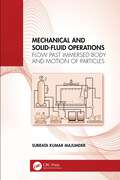- Table View
- List View
Mechanical Testing of Bone and the Bone-Implant Interface
by Yuehuei H. An Robert A. DraughnThe mechanical properties of whole bones, bone tissue, and the bone-implant interfaces are as important as their morphological and structural aspects. Mechanical Testing of Bone and the Bone-Implant Interface helps you assess these properties by explaining how to do mechanical testing of bone and the bone-implant interface for bone-related research
Mechanical Testing of Materials (Solid Mechanics and Its Applications #275)
by Emmanuel Gdoutos Maria Konsta-GdoutosThis book offers a comprehensive and in-depth exploration of the most widely used test methods for characterizing the deformation and failure behavior of materials. It presents a thorough treatise on mechanical testing, providing a valuable resource for researchers, engineers, and students seeking to understand the mechanical properties and performance of materials across various applications. The book is organized into ten chapters dedicated to specific test methods including tensile, compression, bending, torsion, multiaxial, indentation, fracture, fatigue, creep, high strain rates, nondestructive evaluation, ensuring a thorough examination of each technique's principles, procedures, and applications. It features two special chapters focusing specifically on the mechanical characterization of concrete and fiber composite materials. These chapters delve into the unique aspects and challenges associated with testing and analyzing these specific materials.
Mechanical Tests for Bituminous Mixes - Characterization, Design and Quality Control: Proceedings of the Fourth International RILEM Symposium
by H. W. Fritz E. EustacchioThis book forms the Proceedings of an International RILEM Symposium, the fourth in the series, on Testing of Bituminous Mixes in Budapest, Hungary, October 1990. The aim of the Symposium is to promote tests for the characterization, design and quality control of bituminous mixes which combine the best features of traditional and modern approaches.
Mechanical Tolerance Stackup and Analysis (Mechanical Engineering)
by Bryan R. FischerUse Tolerance Analysis Techniques to Avoid Design, Quality, and Manufacturing Problems Before They Happen Often overlooked and misunderstood, tolerance analysis is a critical part of improving products and their design processes. Because all manufactured products are subject to variation, it is crucial that designers predict and understand how thes
Mechanical Tribology: Materials, Characterization, and Applications
by Hong Liang George E. TottenStudying the morphology, defects, and wear behavior of a variety of material surfaces, Mechanical Tribology examines popular and emerging surface characterization techniques for assessment of the physical, mechanical, and chemical properties of various modified surfaces, thin films, and coatings. Its chapters explore a wide range of tribolo
Mechanical Variables Measurement - Solid, Fluid, and Thermal
by John G. WebsterAccuracy in the laboratory setting is key to maintaining the integrity of scientific research. Inaccurate measurements create false and non-reproducible results, rendering an experiment or series of experiments invalid and wasting both time and money. This handy guide to solid, fluid, and thermal measurement helps minimize this pitfall through careful detailing of measurement techniques.Concise yet thorough, Mechanical Variables Measurement-Solid, Fluid, and Thermal describes the use of instruments and methods for practical measurements required in engineering, physics, chemistry, and the life sciences. Organized according to measurement problem, the entries are easy to access. The articles provide equations to assist engineers and scientists who seek to discover applications and solve problems that arise in areas outside of their specialty. Sections include references to more specialized publications for advanced techniques, as well. It offers instruction for a range of measuring techniques, basic through advanced, that apply to a broad base of disciplines.As an engineer, scientist, designer, manager, researcher, or student, you encounter the problem of measurement often and realize that doing it correctly is pivotal to the success of an experiment. This is the first place to turn when deciding on, performing, and troubleshooting the measurement process. Mechanical Variables Measurement-Solid, Fluid, and Thermal leads the reader, step-by-step, through the straits of experimentation to triumph.
Mechanical Ventilation Amid the COVID-19 Pandemic: A Guide for Physicians and Engineers
by Amir A. Hakimi Thomas E. Milner Govind R. Rajan Brian J-F WongThe surge in COVID-19 cases leading to hospitalizations around the world quickly depleted hospital resources and reserves, forcing physicians to make extremely difficult life-or-death decisions on ventilator allocation between patients. Leaders in academia and industry have developed numerous ventilator support systems using both consumer- and industry-grade hardware to sustain life and to provide intermediate respiratory relief for hospitalized patients. This book is the first of its kind to discuss the respiratory pathophysiology underlying COVID-19, explain ventilator mechanics, provide and evaluate a repository of innovative ventilator support devices conceived amid the pandemic, and explain both hardware and software components necessary to develop an inexpensive ventilator support device. This book serves both as a historical record of the collaborative and innovative response to the anticipated ventilator shortage during the COVID-19 pandemic and as a guide for physicians, engineers, and DIY'ers interested in developing inexpensive transitory ventilator support devices.
Mechanical Ventilation in the Critically Ill Obese Patient
by Antonio M. Esquinas Malcolm LemyzeThis book is the first to describe a practical evidence-based approach to the management of critically ill obese patients with various medical or postoperative respiratory problems in the intensive care unit. In brief, the book aims to identify the best strategy and present clinical recommendations for different circumstances, to establish indications for and contraindications to noninvasive and invasive mechanical ventilation, and to offer clear guidance on weaning from mechanical ventilation and on respiratory care. Causes of acute respiratory failure in the obese patient are discussed, and advice is offered on the prevention and management of complications during mechanical ventilation and on moving and feeding critically ill obese patients. Long-term outcomes, ethical issues, and health care costs are also addressed. The multidisciplinary approach, with contributions from international experts in different specialties, ensures that the book will be of interest to a range of health professionals involved in critical care, including intensivists, anesthesiologists, and pulmonologists.
Mechanical Vibration: Analysis, Uncertainties, and Control (Fourth Edition) (Mechanical Engineering #181)
by Haym Benaroya Mark Nagurka Seon HanMechanical Vibration: Analysis, Uncertainties, and Control, Fourth Edition addresses the principles and application of vibration theory. Equations for modeling vibrating systems are explained, and MATLAB® is referenced as an analysis tool. The Fourth Edition adds more coverage of damping, new case studies, and development of the control aspects in vibration analysis. A MATLAB appendix has also been added to help students with computational analysis. This work includes example problems and explanatory figures, biographies of renowned contributors, and access to a website providing supplementary resources.
Mechanical Vibration: Fundamentals with Solved Examples
by Ivana Kovacic Dragi RadomirovicMechanical oscillators in Lagrange's formalism – a thorough problem-solved approach This book takes a logically organized, clear and thorough problem-solved approach at instructing the reader in the application of Lagrange's formalism to derive mathematical models for mechanical oscillatory systems, while laying a foundation for vibration engineering analyses and design. Each chapter contains brief introductory theory portions, followed by a large number of fully solved examples. These problems, inherent in the design and analysis of mechanical systems and engineering structures, are characterised by a complexity and originality that is rarely found in textbooks. Numerous pedagogical features, explanations and unique techniques that stem from the authors’ extensive teaching and research experience are included in the text in order to aid the reader with comprehension and retention. The book is rich visually, including numerous original figures with high-standard sketches and illustrations of mechanisms. Key features: Distinctive content including a large number of different and original oscillatory examples, ranging from simple to very complex ones. Contains many important and useful hints for treating mechanical oscillatory systems. Each chapter is enriched with an Outline and Objectives, Chapter Review and Helpful Hints. Mechanical Vibration: Fundamentals with Solved Examples is essential reading for senior and graduate students studying vibration, university professors, and researchers in industry.
Mechanical Vibration: Theory and Application
by Haym Benaroya Mark Nagurka Seon Mi HanThe Fifth edition of this classic textbook includes a solutions manual. Extensive supplemental instructor resources are forthcoming in the Fall of 2022. Mechanical Vibration: Theory and Application presents comprehensive coverage of the fundamental principles of mechanical vibration, including the theory of vibration, as well as discussions and examples of the applications of these principles to practical engineering problems. The book also addresses the effects of uncertainties in vibration analysis and design and develops passive and active methods for the control of vibration. Many example problems with solutions are provided. These examples as well as compelling case studies and stories of real-world applications of mechanical vibration have been carefully chosen and presented to help the reader gain a thorough understanding of the subject. There is a solutions manual for instructors who adopt this book. Request a solutions manual here (https://www.rutgersuniversitypress.org/mechanical-vibration).
Mechanical Vibrations
by K. Scott Smith Tony L. SchmitzMechanical Vibrations: Modeling and Measurement describes essential concepts in vibration analysis of mechanical systems. It incorporates the required mathematics, experimental techniques, fundamentals of model analysis, and beam theory into a unified framework that is written to be accessible to undergraduate students, researchers, and practicing engineers. To unify the various concepts, a single experimental platform is used throughout the text. Engineering drawings for the platform are included in an appendix. Additionally, MATLAB programming solutions are integrated into the content throughout the text.
Mechanical Vibrations (Dover Civil and Mechanical Engineering)
by J. P. HartogThis classic textbook by J. P. Den Hartog, retired professor of mechanical engineering at MIT, reflects the author's unique ability to combine the scholarly insight of a distinguished scientist with the practical, problem-solving orientation of an experienced industrial engineer. Although mathematics plays a role in the subject, Den Hartog employs the simplest possible mathematical approaches. His lucid explanations of complex problems are presented in a direct style and supported by illustrative models. Numerous figures in the text enhance its value as a basic foundation in a field which Den Hartog calls "a necessary tool for almost every mechanical engineer." The author examines such topics as the kinematics of vibration (including harmonic motions and non-harmonic periodic motions), degrees of freedom, gyroscopic effects, relaxation oscillations, Rayleigh's method, natural frequencies of torsional vibration, Karman vortices, and systems with variable elasticity. Drawing on his experience as an engineer in private industry and in the U.S. Navy's Bureau of Ships, Den Hartog applies theory to practice, discussing the effects of vibrations on turbines, electrical machines, helicopter rotors and airplane wings, diesel engines and electrical transmission lines.As a special aid to classroom work or self-study, this practical text includes an extensive selection of 233 problems and answers that test the student's mastery of every section of the book. In addition, a highly useful Appendix contains "A Collection of Formulas" for determining the load per inch deflection of linear springs, the load per radian rotation of rotational springs, the natural frequencies of simple systems, the longitudinal and torsional vibration of uniform beams, the transverse or bending vibrations of uniform beams, and the vibrations of rings, membranes, and plates.When Mechanical Vibrations was first published in 1934, it was a pioneering work in a field which had just been introduced in America's technical schools. In fact, the author wrote it to assist him in teaching the subject at Harvard. "During the life of the book," he says, "from 1934 on, the art and science of engineering has grown at an astonishing rate and the subject of vibration has expanded with it." Professor Den Hartog's constant revisions have kept his book at the forefront of this vital subject, as useful today as its earlier versions were to students of the past.
Mechanical Vibrations: An Introduction (Foundations of Engineering Mechanics)
by György Szeidl László Péter KissThis book presents a unified introduction to the theory of mechanical vibrations. The general theory of the vibrating particle is the point of departure for the field of multidegree of freedom systems. Emphasis is placed in the text on the issue of continuum vibrations. The presented examples are aimed at helping the readers with understanding the theory.This book is of interest among others to mechanical, civil and aeronautical engineers concerned with the vibratory behavior of the structures. It is useful also for students from undergraduate to postgraduate level. The book is based on the teaching experience of the authors.
Mechanical Vibrations: Modeling and Measurement
by K. Scott Smith Tony L. SchmitzNow in an updated second edition, this classroom-tested textbook describes essential concepts in vibration analysis of mechanical systems.The second edition includes a new chapter on finite element modeling and an updated section on dynamic vibration absorbers, as well as new student exercises in each chapter. It incorporates the required mathematics, experimental techniques, fundamentals of modal analysis, and beam theory into a unified framework that is written to be accessible to undergraduate students, researchers, and practicing engineers. To unify the various concepts, a single experimental platform is used throughout the text to provide experimental data and evaluation. Engineering drawings for the platform are included in an appendix. Additionally, MATLAB programming solutions are integrated into the content throughout the text.The book is ideal for undergraduate students, researchers, and practicing engineers who are interested in developing a more thorough understanding of essential concepts in vibration analysis of mechanical systems.Presents a clear connection between continuous beam models and finite degree of freedom models;Includes MATLAB code to support numerical examples that are integrated into the text narrative;Uses mathematics to support vibrations theory and emphasizes the practical significance of the results.
Mechanical Wave Vibrations: Analysis and Control
by Chunhui MeiMechanical Wave Vibrations An elegant and accessible exploration of the fundamentals of the analysis and control of vibration in structures from a wave standpoint In Mechanical Wave Vibrations: Analysis and Control, Professor Chunhui Mei delivers an expert discussion of the wave analysis approach (as opposed to the modal-based approach) to mechanical vibrations in structures. The book begins with deriving the equations of motion using the Newtonian approach based on various sign conventions before comprehensively covering the wave vibration analysis approach. It concludes by exploring passive and active feedback control of mechanical vibration waves in structures. The author discusses vibration analysis and control strategies from a wave standpoint and examines the applications of the presented wave vibration techniques to structures of various complexity. Readers will find in the book: A thorough introduction to mechanical wave vibration analysis, including the governing equations of various types of vibrations Comprehensive explorations of waves in simple rods and beams, including advanced vibration theories Practical discussions of coupled waves in composite and curved beams Extensive coverage of wave mode conversions in built-up planar and spatial frames and networks Complete treatments of passive and active feedback wave vibration control MATLAB® scripts both in the book and in a companion solutions manual for instructors Mechanical Wave Vibrations: Analysis and Control is written as a textbook for both under-graduate and graduate students studying mechanical, aerospace, automotive, and civil engineering. It will also benefit researchers and educators working in the areas of vibrations and waves.
Mechanical Wear Fundamentals and Testing, Revised and Expanded
by Raymond J. BayerWritten by a tribological expert with more than thirty years of experience in the field, Mechanical Wear Fundamentals and Testing, Second Edition compiles an extensive range of graphs, tables, micrographs, and drawings to illustrate wear, friction, and lubrication behavior in modern engineering applications. The author promotes a clear understandin
Mechanical and Chemical Signaling in Angiogenesis
by Cynthia A. Reinhart-KingThis volume describes and discusses recent advances in angiogenesis research. The chapters are organized to address all biological length scales of angiogenesis: molecular, cellular and tissue in both in vivo and in vitro settings. Specific emphasis is given to novel methodologies and biomaterials that have been developed and applied to angiogenesis research. Angiogenesis experts from diverse fields including engineering, cell and developmental biology, chemistry and physics will be invited to contribute chapters which focus on the mechanical and chemical signals which affect and promote angiogenesis.
Mechanical and Corrosion-Resistant Properties of Plastics and Elastomers
by Philip A. SchweitzerA study of the physical, mechanical and corrosion resistant properties of all the most common commercially available plastics and elastomers. It offers examples of typical applications and describes methods of joining. The physical, mechanical and corrosion resistant properties of 32 thermoplastics, 20 thermosets, and 27 elastomers are provided. Th
Mechanical and Creep Behavior of Advanced Materials
by Indrajit Charit Peter K. Liaw Yuntian T. Zhu Stuart A. MaloyThis collection commemorates the occasion of the honorary symposium that celebrated the 75th birthday and lifelong contributions of Professor K. L. Murty. The topics cover the present status and recent advances in research areas in which he made seminal contributions. The volume includes articles on a variety of topics such as high-temperature deformation behaviors of materials (elevated temperature creep, tensile, fatigue, superplasticity) and their micromechanistic interpretation, understanding mechanical behavior of HCP metals/alloys using crystallographic texture, radiation effects on deformation and creep of materials, mechanical behavior of nanostructured materials, fracture and fracture mechanisms, development and application of small-volume mechanical testing techniques, and general structure-property correlations.
Mechanical and Dynamic Properties of Biocomposites
by Senthilkumar KrishnasamyMechanical and Dynamic Properties of Biocomposites A comprehensive review of the properties of biocomposites and their applicationsMechanical and Dynamic Properties of Biocomposites offers a comprehensive overview of the mechanical and dynamic properties of biocomposites and natural fiber-reinforced polymer composites. This essential resource helps with materials selection in the development of products in the fields of automotive and aerospace engineering as well as the construction of structures in civil engineering.With contributions from a panel of experts in the field, the book reviews the mechanical and damping properties of lingo-cellulosic fibers and their composites. The authors highlight the factors that contribute to the improved properties and their advancements in modern industrialization.Besides, the book is designed to (a) introduce the mechanical and damping properties of lingo-cellulosic fibers and their composites, (b) factors that contribute to improvement in properties such as hybridization, chemical treatment of natural fibers, additive or fillers, etc. and (c) the real-time applications with case studies and future prospects.Key features:Presents viable alternatives to conventional compositesExamines the environmentally friendly and favorable mechanical properties of biocompositesReviews the potential applications of biocomposites in the fields of automotive, mechanical and civil engineeringBrings together in one comprehensive resource information found scattered across the professional literatureWritten for materials scientists, polymer chemists, chemists in industry, civil engineers, construction engineers, and engineering scientists in industry, Mechanical and Dynamic Properties of BIocomposites offers a compreshensive review of the properties and applications of biocomposites.
Mechanical and Industrial Engineering: Historical Aspects and Future Directions (Materials Forming, Machining and Tribology)
by J. Paulo DavimThis book covers historical aspects and future directions of mechanical and industrial engineering. Chapters of this book include applied mechanics and design, tribology, machining, additive manufacturing and management of industrial technologies.
Mechanical and Materials Engineering of Modern Structure and Component Design
by Andreas Öchsner Holm AltenbachThis book presents the latest findings on mechanical and materials engineering as applied to the design of modern engineering materials and components. The contributions cover the classical fields of mechanical, civil and materials engineering, as well as bioengineering and advanced materials processing and optimization. The materials and structures discussed can be categorized into modern steels, aluminium and titanium alloys, polymers/composite materials, biological and natural materials, material hybrids and modern nano-based materials. Analytical modelling, numerical simulation, state-of-the-art design tools and advanced experimental techniques are applied to characterize the materials' performance and to design and optimize structures in different fields of engineering applications.
Mechanical and Solid-Fluid Operations: Characteristics and Handling of Solids
by Subrata Kumar MajumderThe text comprehensively discusses the transport mechanism, storage, and conveying of the material, which are essential requirements for transporting solids in various process units, especially in mineral and chemical industries. It covers the properties of particles and particulate systems and focuses on their characterization and analysis.This book: Presents a discussion of theoretical principles coupled with illustrative examples to help readers learn how to operate, optimize, and innovate particle processing technologies Covers transport characterization of the solid-fluid operations, slurry physical properties, and properties of particles Illustrates systematic and comprehensive understanding of fundamental phenomena of properties of particles and handling of particulate systems Explains graphical representation of particle size, particle size measurement, and particle size distribution Includes ancillary material such as numerical problems, review questions, multiple choice questions, and exercises at the end of each chapter It is primarily written for senior undergraduates, graduate students, and academic researchers in fields including chemical engineering, mechanical engineering, environmental engineering, industrial engineering, manufacturing engineering, and chemistry.
Mechanical and Solid-Fluid Operations: Flow Past Immersed Body and Motion of Particles
by Subrata Kumar MajumderThe text thoroughly discusses the fundamentals of flow resistance over a solid body, the frictional resistance of flow through a granular bed, and the flow phenomena of particles, which are essential requirements for solid-fluid operations in various process units, especially in mineral and chemical industries. It elucidates the fundamentals of drag force on a solid, terminal velocity of the particle, sedimentation, slurry mixing, fluidization phenomena and froth flotation.This book: Presents a discussion of theoretical principles and illustrative examples to help readers learn how to operate, optimize, and innovate particle processing technologies Covers the fundamentals of drag force on a solid, terminal velocity of the particle, and sedimentation (hindered settling) Explain the basic law and terminology of fluid flow through a granular bed, mixing characteristics in an agitator, and its standard design Illustrates systematic and comprehensive understandings of the fundamental phenomena of fluidization and the basic principles and kinetics of froth flotation Includes ancillary material such as numerical problems, review questions, multiple choice questions, and exercises at the end of each chapter It is primarily written for senior undergraduates, graduate students, and academic researchers in chemical engineering, mechanical engineering, environmental engineering, industrial engineering, manufacturing engineering, and chemistry.
